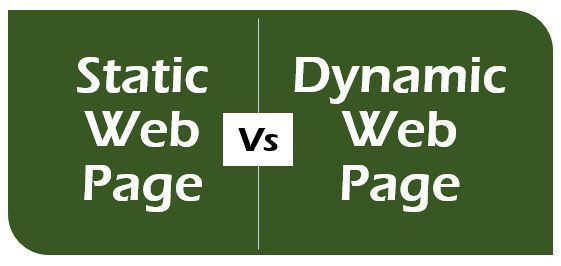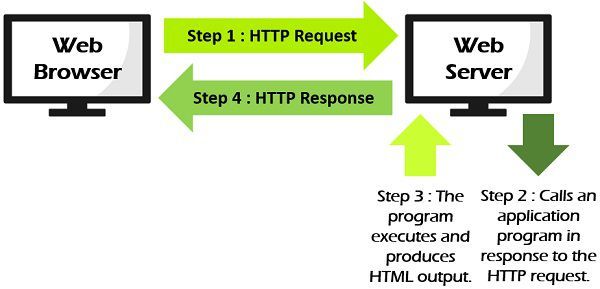 Before understanding static and dynamic web pages, we must understand the working of the internet. Web browser and web server play the main role in any internet-based communication. The Hypertext transfer protocol is used for the transaction between the web browser (client) and the web server (server). In this type of communication the browser sends an HTTP request to the server, and then the server sends an HTTP response to the browser with an HTML page and the communication between them ends. So these types of web pages are known as static web pages.
Before understanding static and dynamic web pages, we must understand the working of the internet. Web browser and web server play the main role in any internet-based communication. The Hypertext transfer protocol is used for the transaction between the web browser (client) and the web server (server). In this type of communication the browser sends an HTTP request to the server, and then the server sends an HTTP response to the browser with an HTML page and the communication between them ends. So these types of web pages are known as static web pages.
On the other hand, in the dynamic web pages, the web server cannot directly send HTML page with the response. It calls a program that is placed on its hard disk to access the database and transaction processing is also performed.
Content: Static Web Pages Vs Dynamic Web Pages
Comparison Chart
| Basis for comparison | Static Web Pages | Dynamic Web Pages |
|---|---|---|
| Basic | Static web pages will remain same for the time until and unless someone changes it manually. | Dynamic web pages are behavioral and have the capacity to produce distinctive content for different visitors. |
| Complexity | Simple to design. | Complicated to construct. |
| Application and web languages used to create web pages | HTML, JavaScript, CSS, etc. | CGI, AJAX, ASP, ASP.NET, etc. |
| Information change | Occurs rarely | Frequently |
| Page loading time | Less comparatively | More |
| Use of Database | Doesn't use databases | A database is used. |
Definition of Static Web Pages
Static web pages are simple and written in the HTML language and stored in web server. Whenever server receives a request regarding a web page, it sends a response along with the requested web page to the client without performing any additional processing. It just locates that page on its hard disk and add HTTP headers, and reply back an HTTP response. The peculiar thing in a static web page is that the content in these types of the web page does not change depending on the request. They are always the same unless the content is changed physically on the server’s hard disk. That is the reason these web pages are known as static web pages.
The peculiar thing in a static web page is that the content in these types of the web page does not change depending on the request. They are always the same unless the content is changed physically on the server’s hard disk. That is the reason these web pages are known as static web pages.
Definition of Dynamic Web Pages
Dynamic web pages provide a solution for the static web pages. The dynamic web page content can vary depending on the number of parameters. As it is discussed above that dissimilar to static web age, it not just simply send HTML page in response. The web server calls a program located on the hard disk which can access a database, perform transaction procedure, etcetera. If the application program produces HTML output, which is used to construct an HTTP response by the web server. The web server sends the HTTP response thus created, back to the web browser.
The dynamic web pages are employed where the information changes very often such as stock prices, weather information, news and sports updates. Let’s assume a person has to physically change the Web page every 10 seconds to show the latest update of the stock prices which is impractical to physically alter the HTML pages very often, so in this case, a dynamic web page can be used.  There are several tools used for the creation of dynamic web pages. For example, CGI (Common Gateway Interface), ASP (Active Server Pages), JSP (Java Server Pages), ASP.NET, AJAX (Asynchronous JavaScript and XML), etc.
There are several tools used for the creation of dynamic web pages. For example, CGI (Common Gateway Interface), ASP (Active Server Pages), JSP (Java Server Pages), ASP.NET, AJAX (Asynchronous JavaScript and XML), etc.
Key Differences Between Static and Dynamic Web Pages
- Static web pages are difficult to alter because it requires the change to be implemented at each point manually that is the reason its content doesn’t change regularly. On the other hand, the structure of dynamic pages is different from static web pages which contain server code and allows the server to generate unique content each time the page is loaded with the same source code.
- The static web page is simple to construct while dynamic web pages are complex to construct and design.
- Static web page involves technology such as HTML, JavaScript, CSS, etcetera for its construction. On the contrary, dynamic web pages are created using CGI (Common Gateway Interface) and languages like AJAX, ASP, PERL, PHP, etcetera server-side scripting languages.
- The static web pages display the same content each time when someone visits it, whereas in dynamic web pages the page content changes according to the user.
- Basic HTML pages can be loaded quickly by consuming less time, that’s why the static web pages load in less time. Conversely, the dynamic web pages take more time while loading.
- A database is used in at the server end in a dynamic web page. In contrast, there is no database used in a static web page.
Conclusion
To sum up the discussion, there is no involvement of application program in the static web page whereas dynamic web page involves an application program which can perform the various operation. Although, static and dynamic web pages have to return HTML contents to the web browser with the use of HTTP protocol, in order to interpret and display them on the browser.
Sahid Singh says
The points have discussed on the above for the Static and the dynamic web pages, is really very informative, and from the points, it is very clear to me what is the actual using purpose or both.
Veronica says
Great article! This is all I needed to clarify the terms.
Raj Hiwale says
Great article! Everything is clear in my mind finally. Thank you so much.
YOGESH ARYAL says
your website is effective to learn thanks for your kind support.
raghav says
great information! I learned a lot from this
tanushree says
gud information ……great work!!!!!
EZD says
Great and easy description. Thanks!
R. S. Apte says
Very clearly & nicely explained..
Thanks a lot
Mindmade Technologies says
Wonderful Blog, Thanks for posting.